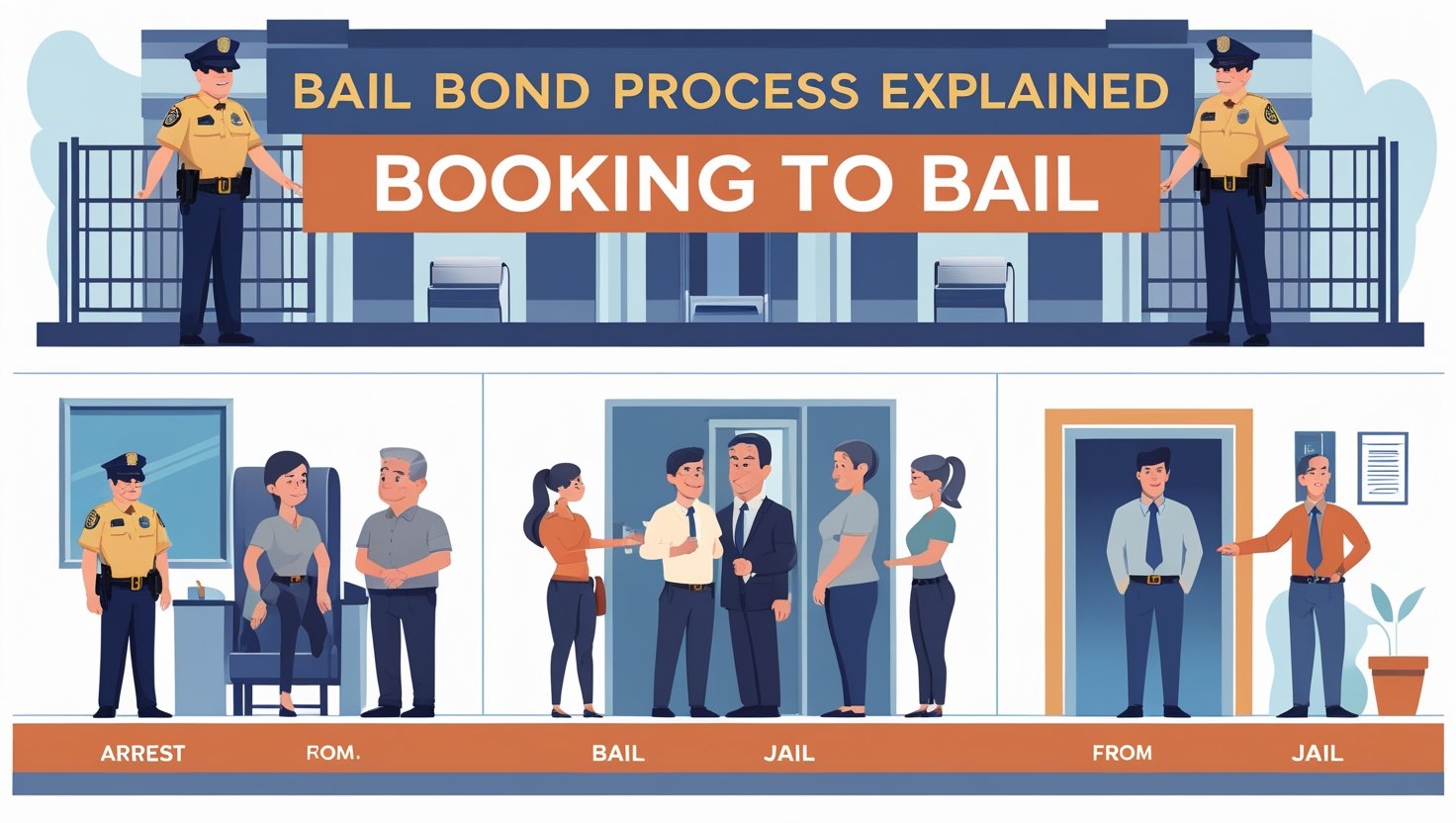When a loved one is arrested, the feeling of helplessness can be overwhelming. The legal system, with its complex terminology and seemingly endless procedures, can feel like a maze without a map. But there is a way through it, and it often begins with a single, crucial step: understanding the bail bond process. This isn’t just about a financial transaction; it’s a series of legal checkpoints that, when navigated correctly, can lead to your loved one’s temporary freedom while they await their day in court. This guide will demystify each stage, from the moment of booking to the final release, providing you with a clear, step-by-step road map.
A Snapshot of the Arrest:
The very first step in the process, of course, is the arrest itself. Once a person is taken into custody, they are transported to a local jail or police department. This isn’t just a holding cell; it’s the beginning of a formal intake procedure known as booking.
During booking, a series of important actions takes place:
- Personal Information Recording: The individual’s name, date of birth, and other identifying details are entered into the system.
- Mugshot and Fingerprinting: The police will take a photograph (mugshot) and record fingerprints. These are used for identification and background checks.
- Criminal Charges Documentation: The specific charges against the individual are officially documented.
This stage is primarily administrative, but it’s a critical foundation for everything that follows. It’s during this time that the defendant’s information is formally entered into the legal system, making them a part of the official record.
The Bail Hearing:
After the booking is complete, the arrested person will typically have an initial court appearance, often referred to as an arraignment or bail hearing. This is a pivotal moment where a judge will decide whether to grant bail and, if so, at what amount. The purpose of bail is simple: it’s a financial guarantee that the defendant will return for all their required court dates. It’s not a fine or a punishment; it’s collateral to ensure their appearance.
A judge’s decision is not arbitrary. They weigh several factors to determine the bail amount, including:
- Severity of the Alleged Crime: More serious or violent crimes often result in higher bail, or in some cases, bail may be denied entirely.
- Flight Risk: The judge will assess the likelihood of the person skipping town. Factors like strong ties to the community, stable employment, and family connections can help demonstrate a lower flight risk.
- Criminal History: A long criminal record, especially one with previous failures to appear, can lead to a higher bail amount.
- Threat to Public Safety: If the judge believes the defendant poses a danger to the community, bail may be set very high or denied altogether.
This hearing is the first real opportunity for a person’s legal representative to make an argument for a more reasonable bail amount.
How Bail Bonds Work:
Once a judge has set the bail amount, the real challenge begins. For many people, the bail amount is financially out of reach. This is where a bail bond becomes an essential tool. A bail bond is a type of surety bond, where a third party, the bail bondsman or bail bond agency, agrees to pay the full bail amount to the court if the defendant fails to show up for their hearings.
This is a crucial distinction: you’re not paying the court directly. Instead, you’re paying a non-refundable fee to the bail bondsman, typically 10% of the total bail amount.
Here’s how this financial bridge is built:
- Connecting with a Bail Bondsman: The family or friends of the defendant will contact a licensed bail bondsman. You’ll need to provide them with key information like the defendant’s full name, the jail they’re in, and the bail amount.
- The Agreement: The bail bondsman will have you sign a contract. This agreement outlines your responsibilities, primarily paying the fee and ensuring the defendant appears in court.
- Posting the Bond: Once the fee is paid, the bail bondsman will go to the jail and post the bail bond. This bond guarantees the court that the full amount is covered.
- Collateral Consideration: For very large bail amounts, the bondsman might require collateral. This could be a house, a car, or other valuable assets that they can seize if the defendant fails to appear in court. This provides extra security for the bondsman.
This system is a financial lifeline for many, allowing a person to be released from jail without having to produce the full bail amount themselves.
Securing Freedom:
After the bail bond is posted, the process moves to the release phase. The time it takes for a defendant to be released from custody can vary widely depending on the jail’s specific procedures, how busy they are, and the time of day.
This phase includes:
- Paperwork and Processing: The jail will process the bail bond paperwork. They need to verify the bond and finalize the release.
- Personal Belongings Retrieval: The person will get their personal belongings back, such as a wallet, phone, and clothing.
- Final Release: Once all paperwork is complete, the individual is released from custody.
It’s important to note that being released on bail is not a “get out of jail free card.” The defendant is released under the condition that they will appear at every single scheduled court hearing. Failing to do so has severe consequences.
The Ongoing Responsibility:
The journey doesn’t end with release. In fact, a new set of responsibilities begins. The defendant is now on pre-trial release, and they must adhere to all the conditions set by the court and the bail bondsman.
- Attending All Court Hearings: This is the most critical obligation. Missing a court date, known as a failure to appear, will result in the forfeiture of the bail bond. This means the bail bondsman loses their money, and you, the co-signer, are now financially responsible for the full bail amount. A new warrant will also be issued for the defendant’s arrest.
- Bail Conditions: The court may impose additional conditions, such as a no-contact order with the victim, refraining from drug or alcohol use, or staying within a certain geographical area.
- Bail Bondsman Communication: Maintaining a relationship with the bail bondsman is crucial. They often provide court reminders and guidance to help the defendant stay on track.
The bail bond remains in effect until the case is officially resolved, whether through a dismissal, a plea bargain, or a trial verdict. Once the court case concludes and all appearances have been made, the bail bond is discharged. The non-refundable fee you paid to the bondsman is their payment for the service, and any collateral you may have provided is returned.
Conclusion:
Navigating the legal system is intimidating, but with a clear understanding of the bail bond process, you can move forward with confidence. From the initial booking to securing release and ensuring compliance, each stage has a specific purpose. By working with a trusted bail bondsman and adhering to the court’s requirements, you can successfully navigate this complex system and help a loved one regain their freedom while they prepare for the legal challenges ahead.
FAQs:
Q1: What is the main purpose of bail?
Bail is a financial guarantee to the court that a defendant will appear for all their scheduled court dates.
Q2: Is the fee paid to a bail bondsman refundable?
No, the fee paid to the bail bondsman, usually 10% of the bail, is a non-refundable service charge.
Q3: What happens if someone on bail misses a court date?
If a person misses a court date, the bail bond is forfeited, a warrant is issued for their arrest, and the co-signer is liable for the full bail amount.
Q4: Can a judge deny bail?
Yes, a judge can deny bail if the defendant is considered a severe flight risk or a significant danger to the community.
Q5: How is the bail amount determined?
The bail amount is determined by a judge based on the severity of the crime, the defendant’s criminal history, and their risk of not appearing in court.
Q6: What is collateral in the bail bond process?
Collateral is an asset, like a car or house, that a bondsman can seize if the defendant fails to appear in court and the bond is forfeited.

